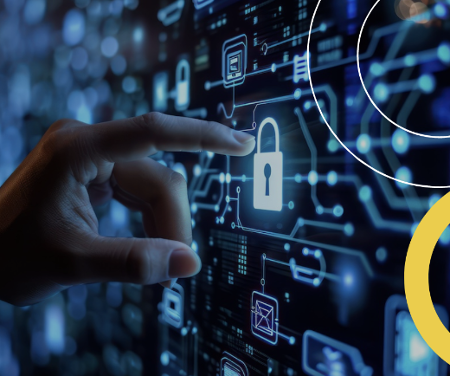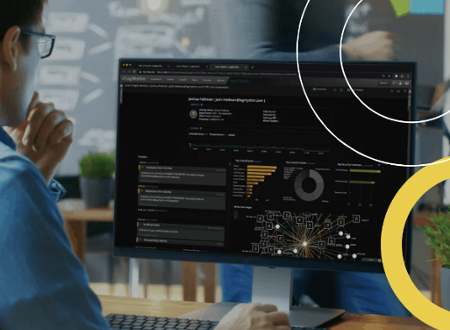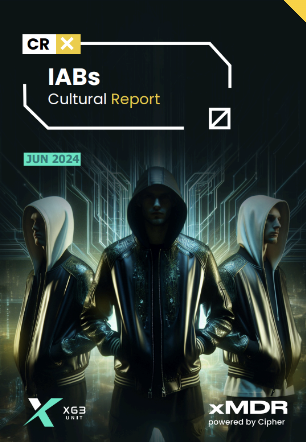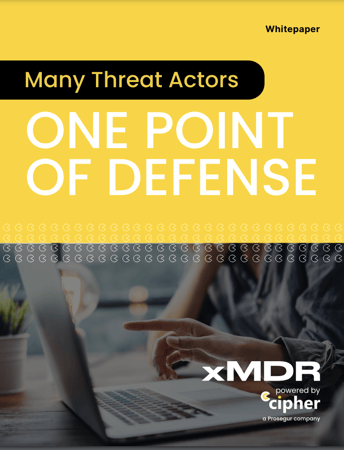Cyber Security Risk Management for Modern Enterprises
Introduction
Organizations are more interconnected than ever before.
Although this connectivity brings new opportunities for organizations to reach customers, identify partners, and grow their operations, it also introduces the chance for cyber attackers to threaten their infrastructure, data, finances, and reputation.
However, how big this risk is, where it is most prevalent, and what can be done to reduce it is where the practice of cybersecurity risk management comes into focus.
Like other cybersecurity processes, risk management isn’t a one-and-done effort; instead, it is a living process that adapts and grows over time. But, once in place, the probability and impact of identified and new risks can be lessened, reducing costly incidents, dodging data breaches, and avoiding regulatory and compliance issues.
Here’s everything you need to know to understand the value of cybersecurity risk management and establish a robust program of your own.
Download a PDF version of this guide by filling out this form, or keep scrolling to learn more.

What Is Risk Management in Cybersecurity?
The Role of Cyber Threat Intelligence in Cybersecurity
The Cybersecurity Risk Management Process: An Overview
Developing a Cybersecurity Risk Management Plan
Special Considerations in Cybersecurity Risk Management
Best Practices for Managing IT Risk
Bringing It All Together
- What Is Risk Management in Cybersecurity?
- The Role of Cyber Threat Intelligence in Cybersecurity
- The Cybersecurity Risk Management Process: An Overview
- Developing a Cybersecurity Risk Management Plan
- Special Considerations in Cybersecurity Risk Management
- Best Practices for Managing IT Risk
- Bringing It All Together

What Is Risk Management in Cybersecurity?
Cybersecurity risk management is a strategic approach to identifying, assessing, and mitigating risks associated with information technology. Risk management encompasses the protection of both digital assets and infrastructure from cyber threats, helping organizations eliminate the potential harm caused by these threats or reduce it to an acceptable level.
A strong risk management program is essential for protecting confidential data, preserving operational continuity, establishing client confidence, and helping organizations adhere to legal and regulatory mandates.
What Are Common Cyber Threats?
The specific variants may evolve and the perpetrators might vary, but common cyber threats include malware, phishing, distributed denial-of-service (DDoS) attacks, and insider threats.
Just as antivirus and cyber threat intelligence tools have become more advanced and prevalent, these cyber threats have also grown more sophisticated and targeted over time.
As a result, they can pose significant risks to organizations, ranging from data breaches, financial losses, and reputational damage to legal liabilities and fines from non-compliance.
Why Cyber Risk Management Is Important
In addition to avoiding the negative consequences mentioned above, taking a proactive approach to cyber risk management can:
- Enhance organizational resilience.
- Facilitate compliance with industry standards and regulations.
- Support strategic decision-making.
- Align limited IT resources with priority needs.
Resources

10 Cybersecurity Metrics You Should Be Monitoring
Effective management of varying performance indices in information security can mean the difference between a practical and efficient project and a complete waste of money.
Read More
20 Important Data Privacy Questions You Should be Asking Now
Security and privacy leaders face some critical decisions in the years ahead to ensure their organization is completely safeguarding data.
Read More
The Role of Cyber Threat Intelligence in Cybersecurity
What Is Cyber Threat Intelligence?
Cyber threat intelligence is evidence-based knowledge about an existing or emerging external danger or hazard to assets. This data can be used to inform decisions regarding an organization’s response to that threat.
For example, threat intelligence—which can be shared by private or public clearinghouses—provides actionable insights into tactics, techniques, and procedures (TTPs), which describe the behaviors, processes, actions, and strategies used by threat actors to engage in cyberattacks.
Advanced knowledge of TTPs is crucial for developing effective security measures to anticipate, prevent, and respond to cyber threats.
The Role of Cyber Threat Intelligence in Cybersecurity
Cyber threat intelligence (CTI) enhances existing and planned defense controls by offering actionable insights based on the analysis of actual threat data.
Whether performed internally, provided by an external partner, or both, CTI involves processing and analyzing data to determine the unique motives, common targets, and tactics of threat actors, giving cybersecurity teams the contextual information they need to identify issues and create targeted solutions for detected or known problems.
More specifically, CTI offers insights into:
- Who is attacking what types of organizations or target system(s).
- What their motivation and capabilities are.
- What indicators of compromise (IOCs) to look for.
This context strengthens a proactive security approach by providing evidence-based information that is adaptable to the evolving threat landscape.
Types of Cyber Threat Intelligence
There are three main types of cyber threat intelligence:
- Strategic Cyber Threat Intelligence: Focuses on the macro-level trends and motivations driving threat actors, providing an overview of the geopolitical, economic, and technological factors influencing cybercriminals and nation-state actors.
This type of intelligence helps organizations understand the big picture, enabling them to align their cybersecurity strategies with broader global and industry trends. For example, strategic CTI might reveal that state-sponsored espionage is increasingly targeting intellectual property in high-tech sectors, prompting companies in those sectors to bolster their protective measures.
- Operational Cyber Threat Intelligence: This form of CTI dives deeper into the specific TTPs used by adversaries, providing detailed insights into how cyberattacks are executed, including the tools, methods, and patterns of behavior associated with threat actors.
In practice, operational intelligence might uncover a new phishing campaign targeting specific industries, allowing organizations to update their email filters and educate employees on the latest phishing tactics.
- Tactical Cyber Threat Intelligence: The most granular level of CTI, this form focuses on specific technical IOCs. This includes malware signatures, IP addresses, domain names, and other technical artifacts associated with cyber threats.
Tactical CTI is essential for incident response teams and security analysts tasked with detecting and mitigating active threats. For example, tactical intelligence might alert security teams to a new variant of ransomware circulating among peers, enabling them to proactively deploy signature-based antivirus definitions and firewall rules to block the malware.
Together, these types of cyber threat intelligence form a comprehensive framework for understanding and combating cyber threats. By combining strategic insights with operational and tactical details, organizations can develop a multifaceted approach to cybersecurity that addresses both the macro and micro aspects of the threat environment.
Resources

5 Proven Steps to Building a Security Awareness Program
How does one undertake an effective end-user security awareness program? How can security awareness be measured?
Read More
ROI of Your Cybersecurity Investment
Cybersecurity done right is the absence of events. Measuring the return of the investment in cybersecurity is an inverse of the negative impact of an event versus the resources to prevent it. What is the return on investment for something that doesn’t happen? To do this, you must forecast uncertainty and make some assumptions.
Read More
The Cybersecurity Risk Management Process: An Overview
The cybersecurity risk management process is a systematic approach to identifying, analyzing, evaluating, and addressing cybersecurity threats based on their potential impact on an organization's assets and operations.
Although it is impossible to eliminate all vulnerabilities or block every cyber attack, prioritizing and managing risks can significantly reduce the likelihood and impact of cyber threats. As the threat environment changes and business operations evolve, it’s important to realize that the risk management process is cyclical and continuous, helping security teams review and adjust controls.
There are several different risk management processes available to reference, but risk management frameworks generally follow these key phases:
-
Risk Framing
Risk framing involves establishing the scope and context for risk management activities, including defining the organization's risk tolerance levels and setting criteria for risk acceptance. This foundational step ensures that other risk management efforts are aligned with the organization's objectives and risk appetite.
-
Risk Assessment
Risk assessment is the process of identifying potential cybersecurity risks and evaluating their likelihood and impact. This step begins with a thorough inventory and examination of the organization's IT environment, including hardware, software, networks, and data.
The goal is to both record existing digital elements and quantify risks in terms of their potential effects on the organization if realized, facilitating prioritization and more informed decision-making regarding risk mitigation and resource allocation.
-
Responding to Risk
Once risks have been recorded and assessed, organizations must decide how to respond to each identified risk.
Common strategies include:
- Mitigation: Reducing the risk through the implementation of a security control.
- Acceptance: Acknowledging the risk without taking action.
- Avoidance: Eliminating the risk by changing the environment.
- Transfer: Shifting the risk to another party, typically through insurance or managed services.
Implementing risk response measures requires careful planning and coordination to ensure that actions taken are effective and aligned with the organization's business objectives, stakeholder expectations, and overall risk management goals.
-
Monitoring
Continuous monitoring is crucial, including regularly reviewing and updating risk assessments, implementing new security controls as needed, and staying informed about emerging threats and vulnerabilities.
As changes are identified, security teams will need to adjust risk management strategies based on the new information and changing intelligence.
Key Roles in IT Risk Management
Risk Management Team
A risk management team comprises several roles that work together to perform risk management functions. Key roles include:
- Executive Leadership Team: Establishes the overall risk tolerance, approves cybersecurity budgets and strategies, and facilitates the integration of a cyber awareness culture throughout the organization.
- Chief Information Security Officer (CISO): Manages the organization's cybersecurity strategy, allocates resources, and manages cyber risks.
- Security Incident Manager: Oversees real-time incident control and monitoring.
- Penetration Testers: Simulates cyberattacks to identify vulnerabilities.
- Security Analysts: Monitors and analyzes the organization's security systems and utilizes tools and techniques to identify vulnerabilities, investigate incidents, and recommend improvements to enhance the security posture.
- Business Unit Representatives: Brings a business perspective to ensure that initiatives align with the organization's goals and operational needs.
Compliance Teams
Compliance teams are responsible for developing, governing, and ensuring adherence to internal policies and external regulations. Their role is critical in ensuring that the organization maintains compliance with cybersecurity standards approved by the leadership team and external laws and regulations.
Audit Teams
Audit teams are responsible for regularly assessing the organization's risk management processes to evaluate their effectiveness. Through audits, organizations can identify gaps in their cybersecurity defenses, measure the performance of risk management efforts, and make necessary adjustments to enhance their security posture.
Resources

Three Approaches to Setting Cyber Security Budgets
With evolving and emerging cyber threats, setting aside enough budget for cyber security initiatives is increasingly important.
Read More
Tips for Organizations to Prepare for a Cybersecurity Breach
The primary purpose of this blog is to provide considerations for C-Level Executives as they prepare for the potential of a cybersecurity breach. It may also be useful for IT Directors and/or Managers.
Read More
Developing a Cybersecurity Risk Management Plan
Backed with a high-level understanding of the risk management process, it’s time to get more granular.
A cybersecurity risk management plan puts the process into action, with the steps, procedures, roles, and responsibilities required to make it come alive. In the below sections, we dive deeper into the risk management process with the steps your team can take:
A. Identify Risks
Common techniques for risk identification include:
- Network-based security assessments
- Application security testing
- Configuration reviews
- Compliance audits
- Penetration testing
- Social engineering assessments
Each of the above techniques targets different aspects of your IT environment, providing a comprehensive view of the organization's cybersecurity vulnerabilities.
B. Assess Risks
Once potential risks have been identified, the next step is to calculate their severity and probability.
Methods for risk assessment include:
- Risk Matrix Approach: A visual tool for evaluating and prioritizing potential risks by plotting the likelihood of a risk event on one axis and the severity of the risk impact on the other. Each square within the matrix will then reflect a specific risk scenario and should be assigned a corresponding risk level based on the intersection of the likelihood and severity.
- Qualitative Risk Analysis: Involves identifying threats or opportunities, estimating their likelihood, and assessing potential impacts using subjective measures and expert judgments. It categorizes risks by source or effect and is typically used in the early stages of projects or when quantitative data is limited. Risks are ranked as "high," "medium," or "low" based on their perceived impact and likelihood.
- Quantitative Risk Analysis: Applies numerical values and verifiable data to measure the acceptability of a risk event outcome. Unlike qualitative analysis, which operates in a generalized space, quantitative analysis uses data to produce a measurable value for the risk. This method is often used to address specific risks in more detail after initial qualitative analysis is conducted.
- Scenario Analysis: Focuses on creating detailed scenarios around each risk to evaluate the potential impact and likelihood. This method helps in understanding the chain of events that could lead to a risk materializing and assessing the overall effect on the organization. Scenario analysis is particularly useful for complex risks, as the direct calculation of probability and impact can be challenging.
- Bow-Tie Analysis: Shows the causes of risk on one side and the consequences on the other, with risk mitigation strategies in between. It's a versatile, visual method applicable across various industries.
Outputs from these risk assessments provide a consistent and objective way to prioritize risks based on their potential impact and likelihood, helping with the allocation of resources for risk mitigation efforts.
C. Identify Possible Risk Mitigation Measures
Based on the outputs of the risk assessment, organizations should explore various options for mitigating or transferring the identified risks.
Ultimately, this may result in implementing new security controls, improving existing ones, or adopting new tools or other best practices. The final choice depends on the nature of the risks, the organization's risk tolerance, and the cost-effectiveness of the solutions.
D. Use Ongoing Monitoring
Incorporating threat intelligence into risk assessment enhances the ability to detect and respond to emerging threats. By leveraging threat intelligence, organizations can refine their risk assessments, prioritize risks based on the latest threat data, and adjust their cybersecurity strategies as new information becomes available.
Continuous monitoring ensures that the risk management plan is a “living document” that remains relevant and effective as an organization evolves.
Resources

Integrating SIEM Within Compliance Programs
At their core, information security and compliance seem like topics that should go hand in hand: InfoSec deals with the daily functions of identifying and responding to threats, while compliance includes responsibilities of implementing IT security controls and effective governance.
Read More-1.png?width=450&length=450&name=Don%E2%80%99t%20Be%20the%20Easy%20Target%20Top%20Cybersecurity%20Mistakes%20Companies%20Make%20(and%20How%20to%20Avoid%20Them)-1.png)
Don’t Be the Easy Target: Top Cybersecurity Mistakes Companies Make (and How to Avoid Them)
All too often, we hear the phrase “what if?” But in today’s climate, it’s not a matter of if but when, and no organization is immune to cyberattacks. Even companies that believe they have robust cybersecurity defenses can be caught off guard by sophisticated and determined attackers.
Read More
Special Considerations in Cybersecurity Risk Management
In addition to capturing internal elements of their business processes, culture, IT environment, and other operational practices into their risk management calculations, organizations also need to weave in special requirements and considerations from external sources:
Regulatory Changes
Staying abreast of regulatory changes that shape an organization’s cybersecurity posture and risk program is essential for ensuring compliance and avoiding legal penalties.
Organizations must continually update their risk management plans to reflect new requirements, standards, and laws to demonstrate their employ and maintain a secure and compliant IT environment.
Vendor Risk
Third-party vendors can introduce significant cybersecurity risks if their respective security postures are not adequately assessed and managed.
During the scoping phase, organizations should consider if conducting thorough security evaluations of vendors is needed. If so, these findings should be included with their internal risk evaluations and their own respective measures should be implemented to mitigate identified risks. This could include contractual provisions that hold vendors accountable for maintaining certain security standards.
Supply Chain
Organizations must also consider the increasing threats to their operations originating from their supply chains. With the rise of interconnected digital ecosystems, the security of a company's partners and suppliers will directly affect its own cybersecurity posture.
As a result, organizations must actively manage and mitigate risks associated with their supply chains, including conducting thorough security assessments of third-party vendors, implementing stringent security protocols, and promoting a culture of cybersecurity awareness among all partners in the supply chain.
Resources

IAB's Cultural Report
This report details the crucial role of Initial Access Brokers (IABs) in the cybercrime ecosystem.
Read More
🔍 Sector Report: Trading & Crypto
Because of its tremendous economic potential, the trading and cryptocurrency sectors are becoming increasingly attractive targets for cybercriminals, with ransomware, data theft, and financial fraud constituting substantial threats.
Read More
Best Practices for Managing IT Risk
Lean Into Collaboration and Communication Tools
Collaboration and communication tools facilitate teamwork and regular information exchange across departments, enhancing the organization's ability to manage cybersecurity risks effectively and quickly.
Utilize Established Risk Management Frameworks
Adopting established risk management frameworks—such as the Software Engineering Institute (SEI) Risk Management Framework or the National Institute of Standards and Technology (NIST) Risk Management Framework—provides a structured approach to managing IT risks. These frameworks offer guidance on best practices and methodologies for identifying, assessing, and mitigating risks.
Use Industry-Leading Managed Detection and Response Services
Turning to managed detection and response (MDR) services is a powerful way for organizations to introduce or enhance their internal cybersecurity capabilities. MDR providers offer around-the-clock monitoring, threat detection, and response services, enabling organizations to quickly identify and mitigate cyber threats from a broader set of threat indicators and intelligence sources.
Leverage Analytics
Using analytics in risk management allows organizations to identify trends, predict future risks, and make data-driven decisions. Analytics can provide valuable insights into the effectiveness of current security measures and guide the implementation of new controls.
Implement Risk and Issue Management Tools
Risk and issue management tools help organizations track, manage, and report on identified risks and issues. These tools support the prioritization of risks, facilitate communication among stakeholders, and ensure that risk management activities align with organizational goals.
Perform Regular Stakeholder Reporting
Proactive, objective, and regular reporting to stakeholders regarding the status of risks, the impact of identified mitigations, and the outcomes of risk management will build trust with internal and senior stakeholders and enable more informed decision-making and resource allocation.
Resources

Many Threat Actors One Point Of Defense
Want to dive into how Cipher’s xMDR Platform revolutionizes defense against tomorrow’s most sophisticated and persistent cyber threats? Download our whitepaper.
Read More
Lockbit OP. Chronos Report
Since February, the NCA, FBI, Interpol, and other organizations have carried out one of the major operations against Lockbit, the dominant ransomware gang in the globe.The x63 Unit has gone over this operation step by step, resulting in this interesting report on a topical issue.
Read More
Bringing It All Together
Introducing the idea of cybersecurity risk management doesn’t have to bring with it the dread of a potential new set of responsibilities, requirements, and restrictions to an already-stretched team.
Instead, when properly woven into an organization’s culture, business operations, and vendor relationships, risk management can be a strategic advantage, equipping organizations with the tools and knowledge to navigate tomorrow's cyber threats while ensuring compliance with rapidly changing legal and regulatory requirements.
By following the steps outlined in this guide, organizations can develop a comprehensive risk management plan that addresses their own unique cybersecurity needs and enables them to remain vigilant and continuously adapt and improve.
Ready to learn more about how your organization can prepare for tomorrow’s cyber threats with the industry’s most advanced cybersecurity detection and response capabilities?
Speak to a Cipher Expert
In the cybersecurity industry, there’s no substitute for experience.
For more than 20 years, we’ve been dedicated to protecting and supporting organizations like yours so they can thrive in today’s digital world. Our talented team of experts is here to provide leading cybersecurity solutions that are proven to reduce risk, optimize security, and enhance your enterprise IT performance, allowing you to focus on your core business with peace of mind.

Ready to Get Started?
If you're ready to discover how Cipher can transform your organization's cybersecurity capabilities, simply fill out the form below. One of our experts will reach out to schedule a personalized consultation that fits your schedule.
Let's secure your future together.